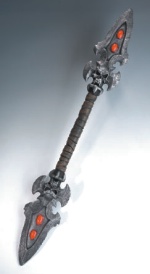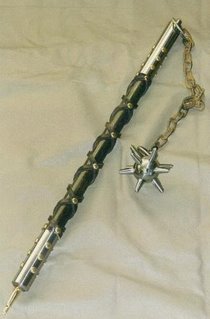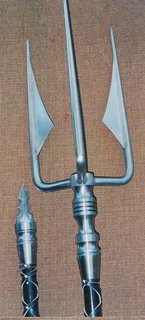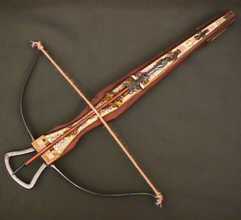Lance
 The lance is a relative of the spear but unlike the spear it was not meant for throwing. It is a much heavier weapon and much more durable. It was particularly effective in two different ways. A group of mounted knights could charge with their lances thus creating a very effective way of breaking through enemy lines. IT could also be used as an effective defense against mounted charges. Lances were much longer and sturdier than their cousin the spear. Usually ranging up to about ten feet in length with the jousting versions sometimes even longer as long as twelve feet or more.
The lance is a relative of the spear but unlike the spear it was not meant for throwing. It is a much heavier weapon and much more durable. It was particularly effective in two different ways. A group of mounted knights could charge with their lances thus creating a very effective way of breaking through enemy lines. IT could also be used as an effective defense against mounted charges. Lances were much longer and sturdier than their cousin the spear. Usually ranging up to about ten feet in length with the jousting versions sometimes even longer as long as twelve feet or more.
Mace
 There are many different variations of maces and they all served specific purposes. The mace shown in the picture here is called a "Flanged Mace" and it was one of the more popular types of maces. It had the pure striking blow force power of a heavy mace but with the addition of the flanges it could also cut through armor. So it was a dual purpose and very effective weapon.
There are many different variations of maces and they all served specific purposes. The mace shown in the picture here is called a "Flanged Mace" and it was one of the more popular types of maces. It had the pure striking blow force power of a heavy mace but with the addition of the flanges it could also cut through armor. So it was a dual purpose and very effective weapon.
Spear
 The most frequent use of the spear was for throwing. But over the centuries they were adapted for the changing needs of hand to hand combat. It has been used in cultures throughout the world because it is inexpensive and easy to make and it is extremely effective. You can attack your enemy without getting too close. .Although there are some interesting variations. The tribal spear is one of the variations. It could be used as a thrown weapon but because of the bladed and hooked end it was also a very effective halbard type weapon. And the spike on the bottom end was very effective at securing the spear into the ground to hold ground against an attack, particularly mounted attacks.
The most frequent use of the spear was for throwing. But over the centuries they were adapted for the changing needs of hand to hand combat. It has been used in cultures throughout the world because it is inexpensive and easy to make and it is extremely effective. You can attack your enemy without getting too close. .Although there are some interesting variations. The tribal spear is one of the variations. It could be used as a thrown weapon but because of the bladed and hooked end it was also a very effective halbard type weapon. And the spike on the bottom end was very effective at securing the spear into the ground to hold ground against an attack, particularly mounted attacks.
Battle Axe

 The Medieval Axe was a fearsome weapon. It combined many different tactics into one weapon. The Main blade of course was something to be feared but there were other things that made it a feared weapon. The Medieval axe often had a pick like weapon opposite the blade as in this example. Sometimes it had a second blade or even a hammer. It was a feared close combat weapon. Many of them also had some kind of tool at the bottom of the handle. This could be used to pierce and puncture. The one shown here has a metal spike
The Medieval Axe was a fearsome weapon. It combined many different tactics into one weapon. The Main blade of course was something to be feared but there were other things that made it a feared weapon. The Medieval axe often had a pick like weapon opposite the blade as in this example. Sometimes it had a second blade or even a hammer. It was a feared close combat weapon. Many of them also had some kind of tool at the bottom of the handle. This could be used to pierce and puncture. The one shown here has a metal spike
Flail

 The flail is a medieval weapon made of one or more weights attached to a handle with a hinge or chain. There is some disagreement over the names for this weapon; the terms morning star and even mace are variously applied, though these are used to describe other weapons, which are very different in usage from a weapon with a hinge or chain, commonly used in Europe from the 13th century to the 15th century. It is also vulgarly referred to as a bombyknocker.The flail was a deadly medieval age weapon used in military warfare, however many flails were also used to administer punishment for crimes against the state and church.
The flail is a medieval weapon made of one or more weights attached to a handle with a hinge or chain. There is some disagreement over the names for this weapon; the terms morning star and even mace are variously applied, though these are used to describe other weapons, which are very different in usage from a weapon with a hinge or chain, commonly used in Europe from the 13th century to the 15th century. It is also vulgarly referred to as a bombyknocker.The flail was a deadly medieval age weapon used in military warfare, however many flails were also used to administer punishment for crimes against the state and church.
Trident
 A TRIDENT is a three-toothed fork or spear. Most famously the Trident was a symbol of Poseidon's (the Greek God of the Sea) power but it has also been linked to other religions and cultures. The Hindu God Shiva is said to have a trident with a stabiliser so that it will fly when thrown as a weapon. Roman gladiators were reputed to use them in the arena in conjunction with a net. Satan is often portrayed with a trident in his possession. The trident is also a symbol of the sea and is the central symbol in the flag of Barbados.
A TRIDENT is a three-toothed fork or spear. Most famously the Trident was a symbol of Poseidon's (the Greek God of the Sea) power but it has also been linked to other religions and cultures. The Hindu God Shiva is said to have a trident with a stabiliser so that it will fly when thrown as a weapon. Roman gladiators were reputed to use them in the arena in conjunction with a net. Satan is often portrayed with a trident in his possession. The trident is also a symbol of the sea and is the central symbol in the flag of Barbados.
Bows
 Bows were most commonly used in battle it was good for a long distance shot. Regular bows were the first to be used, but bows in general had great accuracy and penetrated a soldier's armor. Many pesants used bows because they were easy to make and cost very little money.Crossbows were more efficient and got the job done faster and better. The crossbow dates back to as early as 340 bc, it became widely used throughout Europe during the Middle Ages in the 13th century. The crossbow was used for war & sport and came in a variety of shapes and sizes.Many people consider the crossbow a "pistol" type weapon.
Bows were most commonly used in battle it was good for a long distance shot. Regular bows were the first to be used, but bows in general had great accuracy and penetrated a soldier's armor. Many pesants used bows because they were easy to make and cost very little money.Crossbows were more efficient and got the job done faster and better. The crossbow dates back to as early as 340 bc, it became widely used throughout Europe during the Middle Ages in the 13th century. The crossbow was used for war & sport and came in a variety of shapes and sizes.Many people consider the crossbow a "pistol" type weapon.
Swords

 Swords played a big role and was the most used weapon of the medieval ages. There were mainly two categories of swords. Single-handed-swords and two-handed-swords. single swords were very popular to the lower class people because they were very sharp and meant death because of there sharp deep cuts. A trick that the people used was to put snake venom on the swords before battle so they know there opponet or opponets death was guaranteed. Two-handed-swords weren't as popular because of there heavy weight, a warrior would have heavy armor and a heavy sword, thus only strong men could withhold that amount of weight. Swords were the most common weapon for rich or for poor swords were very important.
Swords played a big role and was the most used weapon of the medieval ages. There were mainly two categories of swords. Single-handed-swords and two-handed-swords. single swords were very popular to the lower class people because they were very sharp and meant death because of there sharp deep cuts. A trick that the people used was to put snake venom on the swords before battle so they know there opponet or opponets death was guaranteed. Two-handed-swords weren't as popular because of there heavy weight, a warrior would have heavy armor and a heavy sword, thus only strong men could withhold that amount of weight. Swords were the most common weapon for rich or for poor swords were very important.
Trebuchets

 Trebuchets were used to fight an enemy. Most medieval trebuchets could hold up to 200lbs. and held rocks or dead animals, then they were pulled down and flung at the target or enemy. It is said that trebuchets were directly invented from the french but, later spread to the rest of Europe. It is unknown who invented the trebuchet because more then one man built it, but we do know it began in from the french. They would use trebuchets to launch at big walls or castle's to knock them down and attack the enemy. Trebuchets were mostly sucsess the only problem was the enormus size of this weapon, It was a great hassle to haul the enormus thing. It also took many people to operate that piece of machinery. Overall trebuchets were a big sucsess for the medieval armies.
Trebuchets were used to fight an enemy. Most medieval trebuchets could hold up to 200lbs. and held rocks or dead animals, then they were pulled down and flung at the target or enemy. It is said that trebuchets were directly invented from the french but, later spread to the rest of Europe. It is unknown who invented the trebuchet because more then one man built it, but we do know it began in from the french. They would use trebuchets to launch at big walls or castle's to knock them down and attack the enemy. Trebuchets were mostly sucsess the only problem was the enormus size of this weapon, It was a great hassle to haul the enormus thing. It also took many people to operate that piece of machinery. Overall trebuchets were a big sucsess for the medieval armies.













